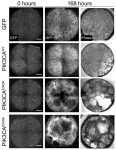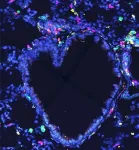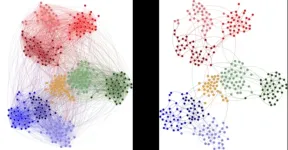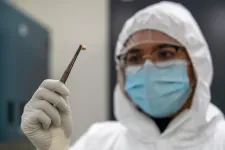(Press-News.org) For two decades, scientists have observed an elongated object named X7 near the supermassive black hole at the center of the Milky Way and wondered what it was. Was it pulled off a larger structure nearby? Was its unusual form the result of stellar winds or was it shaped by jets of particles from the black hole?
Now, having examined the evolution of X7 using 20 years of data gathered by the Galactic Center Orbit Inintiative, astronomers from the UCLA Galactic Center Group and the Keck Observatory propose that it could be a cloud of dust and gas that was ejected during the collision of two stars.
Over time, they report, X7 has stretched, and it is being pulled apart as the black hole drags it closer, exerting its tidal force upon the cloud. They expect that within the next few decades, X7 will disintegrate and the gas and dust of which it is composed will eventually be drawn toward the black hole, which is called Sagittarius A*, or Sgr A*.
The study is published in The Astrophysical Journal.
“No other object in this region has shown such an extreme evolution,” said Anna Ciurlo, a UCLA assistant researcher and the paper’s lead author. “It started off comet-shaped and people thought maybe it got that shape from stellar winds or jets of particles from the black hole. But as we followed it for 20 years we saw it becoming more elongated. Something must have put this cloud on its particular path with its particular orientation.”
X7 has a mass of about 50 Earths and is on an orbital path around Sgr A* that would take 170 years to complete.
But that might never happen. Based on its trajectory, the team estimates that X7 will make its closest approach to Sgr A* around the year 2036, and then likely spiral toward Sgr A* and disappear.
“We anticipate the strong tidal forces exerted by the galactic black hole will ultimately tear X7 apart before it completes even one orbit,” said co-author Mark Morris, UCLA professor of physics and astronomy.
Tidal forces are the gravitational pull that cause an object approaching a black hole to stretch; the side of the object closest to the black hole is pulled much more strongly than the opposite end.
X7 shows some of the same properties as the other strange dusty objects orbiting Sgr A*. Those so-called G objects look like gas but behave like stars. But X7’s shape and velocity have changed more dramatically than G objects’ have. As it accelerates toward the black hole, X7 is moving rapidly, clocking in at speeds of up to around 700 miles per second.
“It's exciting to see significant changes of X7’s shape and dynamics in such great detail over a relatively short time scale as the gravitational forces of the supermassive black hole at the center of the Milky Way influences this object,” Randy Campbell, a co-author of the paper and the science operations lead at the Keck Observatory, said in a statement.
Although X7’s origin is still the subject of debate, the finding suggests that it arose after two stars collided.
“One possibility is that X7’s gas and dust were ejected at the moment when two stars merged,” Ciurlo said. “In this process, the merged star is hidden inside a shell of dust and gas, which might fit the description of the G objects. And the ejected gas perhaps produced X7-like objects.”
The merger of two stars is very common, especially when they are near black holes, Ciurlo said.
“This is a very messy process: The stars circle each other, get closer, merge, and the new star is hidden within a cloud of dust and gas,” she said. “X7 could be the dust and gas ejected from a merged star that’s still out there somewhere.”
The findings are the first estimate of X7’s mildly elliptical orbit and the most robust analysis to date of the remarkable changes to its appearance, shape and behavior. The research team will continue to use the Keck Observatory to monitor X7’s dramatic changes as the power of the black hole’s gravity yanks it apart.
“It’s a privilege to be able to study the extreme environment at the center of our galaxy,” Campbell said in the statement. “This study can only be done using Keck’s superb capabilities, and performed at the very special and revered Maunakea, with honor and respect to the mauna.”
END
A mysterious object is being dragged into the supermassive black hole at the Milky Way’s center
UCLA astronomers think the object, X7, might be debris cloud from a stellar collision
2023-02-24
ELSE PRESS RELEASES FROM THIS DATE:
How a new blood-vessel-on-a-chip can help researchers further understand vascular malformations
2023-02-24
CHAPEL HILL, N.C. – Our bodies are made up of 60,000 miles of complex pipes that play a vital role in transporting nutrients throughout our bodies, performing waste disposal, and supplying our organs with fresh oxygen and blood.
Vascular malformations (VMs) are a group of rare genetic disorders that causes an abnormal formation of veins, arteries, capillaries, or lymphatic vessels at birth. VMs can interfere with the duties of our precious pipes by causing blockages, poor drainage, and the formation of cysts and tangles.
To address a need for further study, William Polacheck, PhD, an assistant professor at the ...
CHOP researchers identify molecules that optimize immune presentation of antigens across the human population
2023-02-24
Philadelphia, February 24, 2023—Researchers at Children’s Hospital of Philadelphia (CHOP) have identified variants of a chaperone molecule that optimizes the binding and presentation of foreign antigens across the human population, which could open the door to numerous applications where robust presentation to the immune system is important, including cell therapy and immunization. The findings were published today in Science Advances.
Class I major histocompatibility complex (MHC-I) proteins are ...
Researchers find several oceanic bottom circulation collapses in the past 4.7 million years
2023-02-24
Antarctic bottom water (AABW) covers more than two-thirds of the global ocean bottom, and its formation has recently decreased. However, its long-term variability has not been well understood.
Researchers led by Prof. DENG Chenglong from the Institute of Geology and Geophysics (IGG) of the Chinese Academy of Sciences (CAS) and their collaborators have reconstructed AABW history back to approximately 4.7 million years ago (mya). They found that AABW has collapsed several times and such collapses might have induced moisture transport to fuel the Northern Hemisphere ...
Protection against allergic asthma: When innate lymphoid cells educate alveolar macrophages
2023-02-24
A study conducted by researchers at the University of Liège on group 2 innate lymphoid cells (or ILC2s) shows that the functional reprogramming of these cells following their exposure to viruses allows our body to react differently to exposure to certain respiratory allergens. This study is published in Science Immunology.
The hygiene hypothesis states that exposure during childhood to certain micro-organisms protects against the development of allergic diseases such as asthma. In this context, researchers from the immunology-vaccinology laboratory (FARAH research ...
Researchers investigate pre-clinical model for clinically relevant treatments for heart attacks
2023-02-24
CÚRAM SFI Research Centre for Medical Devices researchers have published in Nature Communications a key study establishing a new pre-clinical model to develop clinically relevant treatments for heart attacks.
Heart attacks (myocardial infarction (MI)) occur due to an acute complication of coronary artery disease and are a major cause of global mortality. The two main types of heart attack are ST-elevation (STEMI) and Non-ST elevation (NSTEMI). A non-ST-elevation is a type of heart attack that usually happens when your heart's oxygen needs are unmet. This condition gets its name because it doesn't have an easily identifiable electrical pattern like with an ...
Palliative care doesn’t improve psychological distress
2023-02-24
Palliative care — a specialized medical care focused on quality of life for people with a serious illness such as cancer or heart failure — isn’t likely to reduce psychological distress, according to a Rutgers study.
Researchers involved with the study, published in the Journal of Pain and Symptom Management, found there were no statistically significant improvements in patient or caregiver anxiety, depression or psychological distress in a meta-analysis of 38 randomized clinical trials of palliative care interventions. This study took results ...
Research brief: Verapamil shows beneficial effect on the pancreas in children with newly-diagnosed type 1 diabetes
2023-02-24
MINNEAPOLIS/ST. PAUL (02/24/2023) — Published in JAMA, a University of Minnesota led study shows that verapamil, a drug commonly used to treat high blood pressure and heart conditions, can have a beneficial effect on the pancreas in children with newly-diagnosed type 1 diabetes (T1D).
Results of the CLVer clinical trial showed that oral verapamil taken once a day improved the pancreas' insulin secretion by 30% over the first year following diagnosis of T1D when compared with a control group that received a placebo.
“The beneficial effect of verapamil observed in the trial is extremely exciting,” said Antoinette Moran, MD, the ...
A simpler way to track the spread of infectious diseases
2023-02-24
How society organizes affects different phenomena, from the transmission of information to the spread of contagious diseases. The more links we establish with each other via social and transportation networks, the more spread is favored. To study the dynamics of complex systems, such as society, we can infer these networks – in which nodes, representing individuals, connect through lines – from real-world data. However, these networks are usually large, dense, and cumbersome to manipulate.
In previous work, Luís M. Rocha’s group at the Instituto Gulbenkian de Ciência (IGC) found a way to simplify networks ...
Deadly waves: Researchers document evolution of plague over hundreds of years in medieval Denmark
2023-02-24
Attention editors: Under embargo by the journal Current Biology until Friday, February 24 at 11 a.m. eastern
Scientists who study the origins and evolution of the plague have examined hundreds of ancient human teeth from Denmark, seeking to address longstanding questions about its arrival, persistence and spread within Scandinavia.
In the first longitudinal study of its kind, focusing on a single region for 800 years (between 1000-1800AD), researchers reconstructed Yersinia pestis genomes, the bacterium responsible for the plague, and showed that it was reintroduced into the Danish population from other parts of Europe again and again, perhaps via ...
Current air pollution standards tied to higher heart risks
2023-02-24
OAKLAND, Calif. — Long-term exposure to air pollution is tied to an increased risk of having a heart attack or dying from heart disease — with the greatest harms impacting under-resourced communities, new Kaiser Permanente research shows.
The study, published February 24 in JAMA Network Open, is one of the largest to date to look at the effects of long-term exposure to fine particle air pollution, which is emitted from sources such as vehicles, smokestacks, and fires. Fine particle air pollution, also known as PM2.5, are fine particles that are 2.5 micrometers in diameter or smaller. The ...
LAST 30 PRESS RELEASES:
Chicago health information leader recognized for raising CPR readiness and blood pressure awareness
The Intimate Animal, a new book from Kinsey Institute Executive Director Dr. Justin Garcia
When blue-collar workers lose union protection, they try self-employment
New video dataset to advance AI for health care
MEA-based graph deviation network for early autism syndrome signatures in human forebrain organoids
New modeling approach sheds light on rare gut disease
Study documents potentially hazardous flame retardants in firefighter gear
Can certain bacteria regulate aging of the immune system and its related alterations?
AI model helps diagnose often undetected heart disease from simple EKG
There are fewer online trolls than people think
Cell membrane fluctuations produce electricity
Jeonbuk National University study shows positive parenting can protect adolescents against self-harm
Surface-engineered ZnO nanocrystals to tackle perfluoroalkyl substance contamination
This new understanding of T cell receptors may improve cancer immunotherapies
A new fossil face sheds light on early migrations of ancient human ancestor
A new immunotherapy approach could work for many types of cancer
A new way to diagnose deadly lung infections and save lives
40 percent of MRI signals do not correspond to actual brain activity
How brain-inspired algorithms could drive down AI energy costs
Gum disease may be linked to plaque buildup in arteries, higher risk of major CVD events
Contrails are a major driver of aviation’s climate impact
Structure of dopamine-releasing neurons relates to the type of circuits they form for smell-processing
Reducing social isolation protects the brain in later life
Keeping the heart healthy increases longevity even after cancer
Young adults commonly mix cannabis with nicotine and tobacco
Comprehensive review illuminates tau protein's dual nature in brain health, disease, and emerging psychiatric connections
Book prepares K-12 leaders for the next public health crisis
Storms in the Southern Ocean mitigates global warming
Seals on the move: Research reveals key data for offshore development and international ecology
Sports injuries sustained during your period might be more severe
[Press-News.org] A mysterious object is being dragged into the supermassive black hole at the Milky Way’s centerUCLA astronomers think the object, X7, might be debris cloud from a stellar collision




